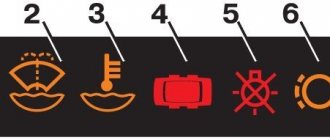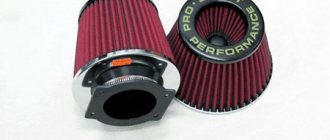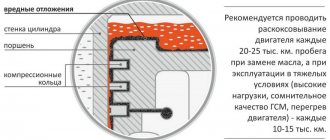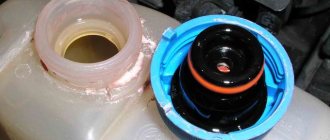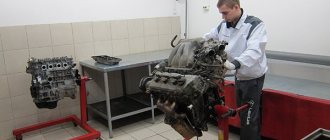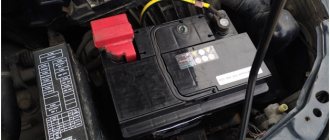1_no_copyright
The modernization of the eight-valve VAZ-21114 engine was brought closer by two major events: the release of Grants to the market and the transition of the entire model range to the next environmental level - Euro-4. And although the old 1.6-liter, despite its advanced age (its roots stretch back to the mid-80s of the last century), did not look like a frail old man, new standards and trends required extensive changes. At the same time, the possibilities for maneuver for motorists, as often happens, were narrowed by financial limits.
Therefore, we went along the already beaten path. After all, several years earlier, a 16-valve engine of the same volume (VAZ-21126) underwent an update, on which some technical solutions were tested. Moreover, they were able to unify not only the approach, but also many details, for example, a connecting rod with liners, a piston pin and rings. The cylinder block, although with its own index, is exactly like that of the VAZ-21126 engine: with additional nozzles for cooling the pistons with oil and plate-honing of the cylinder walls, which reduces the break-in time.
However, it was not possible to copy all the changes exactly: organizing the workflow in an engine with two valves per cylinder is more difficult. Moreover, the requirements for the modernized eight-valve engine turned out to be stricter. Take, for example, the resource - 160 thousand km for the VAZ-21126 and 200 thousand km for the VAZ-21116. Photos with captions will tell you what was changed and why.
Design Features
Important changes that occurred in the 21116 engine include the replacement of the connecting rod and piston group. It was ordered from Federal Mogul under catalog number 1004010. Now the connecting rod and piston group has become lightweight. Thanks to this replacement, the engine power increased, vibration and extraneous sounds from the engine in the cabin decreased. Reduced fuel consumption.
Now the connecting rod and piston group is equipped with the following parts:
- oil rings of sizes 1.2, 1.5, 2 mm;
- connecting rod parts designed for VAZ 21116.
The VAZ engine cooling system was changed. The number of nozzles for cooling the pistons with lubricant has been increased. The cylinder diameter was set at 82 mm and the height at 197.1 mm. The cylinders are plate-honed.
Similar article Review of the Mercedes M113 engine
The gas distribution mechanism was made more reliable and powerful. Instead of a chain, they installed a belt, since when it broke, the valves constantly bent. The lifespan of a timing belt is 200 thousand kilometers.
Attention! The belt was purchased from. It can be found under catalog number 21116-1006040-00. Timing belt width – 22 mm.
Due to changes in the gas distribution mechanism, it was necessary to install a spacer washer under VAZ catalog number 21116-1005317 on the crankshaft. Installing this part allowed the pulleys not to change their position during operation.
Additionally, the following components were introduced:
- automatic tensioner for toothed belt;
- toothed pulley for crankshaft;
- toothed pulley for camshaft.
The weight of the VAZ engine is 112 kg, despite the fact that the cylinder block is cast from cast iron. It is characterized by increased resistance to overheating.
Since the eight-valve engines of the VAZ 21114, this engine is distinguished by smooth operation and automatic control, because an injection system is used. Economy is also excellent. For example. On the highway, fuel consumption is 7.5 liters per 100 km.
H
H
Using computer modeling, we selected the optimal flow section of the gas channels, improving their throughput and reducing inlet losses. Since the power was increased, the engine became more thermally loaded, so it was necessary to include an additional operation in the technological process - heat treatment. By the way, all 16-valve heads pass it. In addition, for the sake of more efficient heat removal, the cross-section of the cooling channels was increased, but only those that really needed it.
Engine VAZ 21116-100026080. Characteristics of the VAZ 21116 engine.
The engine is four-stroke, with distributed fuel injection, in-line, with an overhead camshaft. The engine cooling system is liquid, closed type, with forced circulation of liquid. The engine has a combined lubrication system: pressure and splash.
| Number of cylinders: | 4 |
| Cylinder displacement, l: | 1,597 |
| Compression ratio: | 10,5 |
| Rated engine power at a crankshaft speed of 5600 rpm: | 66 kW.-(90.0 hp) |
| Cylinder diameter, mm: | 82 |
| Piston stroke, mm: | 75,6 |
| Number of valves: | 8 |
| Minimum crankshaft speed, rpm: | 800-850 |
| Maximum torque at 3500 rpm, N*m: | 143 |
| Cylinder operating order: | 1-3-4-2 |
| Octane number of gasoline: | 95(unleaded) |
| Fuel supply system: | Electronically controlled distributed injection. |
| Spark plug: | A17DVRM, BPR6ES(NGK) |
The VAZ 21116 engine is developed on the basis of the 21114 (11183) model. Assembly of small batches has been carried out since June 2011. Serial production of the engine is scheduled for October 2011. The engine is planned to be installed on the LADA Granta in the “Norma” configuration. The new motor is considered as a replacement for models 21114 (11183).
The LADA Granta engine - VAZ 21116, has a cylinder block with a height of 197.1 mm. To finish the surface of the block cylinders, plate honing is used (as on block 21126). For more intensive cooling of the pistons, oil nozzles are provided in the block.
Crankshaft mod. 11183 has a crank radius of 37.8mm. Changing the timing drive required the use of a new spacer washer on the crankshaft (21116 -1005317) for the correct position of the pulleys.
The LADA Granta VAZ 21116 engine uses a connecting rod and piston group from Federal Mogul - 21116 -1004010. Original piston mod. 21116, connecting rod model 11194 (used in the ShPG 21126 kit), piston rings with a height of 1.2/1.5/2 mm. As a result, a significant reduction in the mass of the connecting rod and piston group was obtained, which influenced the improvement of the main technical indicators - increased power, reduced vibration and noise, and reduced specific fuel consumption.
The new 8-valve cylinder head has the index “11186”. The head has additional mounting points for the new timing belt tensioning mechanism. There are differences in the platform and in the fastening of the receiving pipe. Hydraulic valve lifters are not provided.
The head gasket is new 21116-1003020-00, metal two-layer (similar to mod. 21126), thickness 0.43 mm.
For the timing drive, a belt 21116-1006040-00 manufactured by Gates is used, with a width of 22 mm and a service life of 200 thousand km (according to the manufacturer). The use of a new belt required the introduction of new parts into the engine design:
automatic toothed belt tensioner – 21116-1006238-00;
crankshaft gear pulley – 21116-1005030-00;
camshaft gear pulley – 21116-1006020-00.
The motor is equipped with a new intake module 21116-1008600, with a new mounting bracket. At the outlet, a new muffler exhaust pipe with neutralizer 21116-120300815 is installed. The engine complies with Euro 3 environmental requirements.
The ignition system of the VAZ 21116 engine does not use individual coils and, in general, it corresponds to the system of the VAZ 21114 engine.
The VAZ 21116 engine installed on the LADA Granta allows you to obtain the following characteristics for the car:
— fuel consumption in the urban cycle: 8.5 liters. per 100 km;
— fuel consumption on the highway: 5.7 liters. per 100 km;
— maximum speed: 167.0 km/h.
Installation of engine ignition 21116:
H
H
It not only frees you from unnecessary operations, but also ensures correct tension, which affects the service life no less than the quality of the belt itself. If you overtighten, the roller and water pump bearings will suffer. The latter, by the way, has also been modernized: a more reliable bearing and oil seal have been installed, and the performance has also been increased (the unit is from a sixteen-valve engine, only with a pulley for a narrow belt).
Advantages and disadvantages
VAZ 21116 is an easy-to-maintain and at the same time reliable engine. Once every 15,000 kilometers it is necessary to change the engine oil. The timing belt should be inspected every 25,000 kilometers, and replaced after 200,000 km.
The advantages include the low cost of the cylinder head and reduced noise level. And major repairs can be carried out by a car owner who has experience in disassembling and assembling engines. This is possible because the engine components are interchangeable. Easy dismantling of mounted elements makes it unnecessary to disassemble the engine part of the vehicle.
Similar article Technical characteristics of the 1JZ GTE VVTi engine
The advantages of the VAZ engine include:
- ease of repair;
- good traction at low speeds;
- there is no need to tighten the timing belt, since the tensioner is in effect. If you try to tension the belt and tighten it yourself, the roller bearings and water pump will fail;
- The timing drive is protected by a plastic impact-resistant casing;
- economical fuel consumption;
- reliability and durability.
However, there are also disadvantages to this unit. Experienced car owners note:
- the need to regulate valve clearances, since there are no hydraulic compensators;
- frequent malfunctions during operation of even a new VAZ engine;
- low environmental friendliness, which does not meet European standards and does not reach modern Euro 4;
- purchase of expensive foreign components.
The unit often has problems with some sensors at idle. This is a childhood disease that was abandoned by engineers from the moment the engine was released. Therefore, it cannot be corrected and you have to accept it.
Nikolay GANYUSHKIN, head of the engine design bureau
The modernization of the eight-valve engine for front-wheel drive models took two years. The main goals were to reduce fuel consumption and increase dynamic performance by reducing mechanical engine losses, and at the same time reducing harmful vibrations and noise. And of course, increased reliability. Euro 4 standards require that the engine maintain its original emissions parameters twice as long - up to 160 thousand km. And we almost doubled the resource: from 120 thousand to 200 thousand km. The connecting rod and piston group of the VAZ-21116, like the sixteen-valve one, is purchased. In the future, we plan to produce some parts ourselves, and we will continue to purchase some from foreign partners from the Federal Mogul group, who intend to localize the production of components in Russia. We also take into account the interests of the Renault-Nissan alliance. If engine production volumes increase, then it would be reasonable to purchase additional equipment and organize the production of connecting rod and piston group parts in Togliatti.
New VAZ-21116 engine: with a light heart
Malfunctions and repairs
The design of the internal combustion engine is simple and reliable. The most unpleasant situation is when the timing belt breaks, causing the pistons to bend the valves. Correcting it is labor-intensive, expensive, and is possible at a service station.
Apart from the above, the motor does not create problems for owners during operation. The most common problems:
- The power unit operates uncertainly. This may be due to decreased compression or burnt valves. Eliminated by replacing rings and valves.
- The temperature of the coolant (coolant) increases. This happens due to a broken thermostat or pump. You can limit yourself to repairing parts or replace the entire assembly with a new one.
- The engine operates intermittently and loses power. The reason must be sought in the production of spark plugs or a break in the high-voltage wire. Eliminate it by replacing the wires and spark plugs.
- The engine stalls. There is only one reason - a failure in the valve settings and their thermal clearances. The problem requires periodic adjustment of the latter every 15-30 thousand kilometers.
- Increased oil consumption. This may be due to a weak valve cover seal. This can be fixed by replacing the seal.
Modifications of 8 and 16 valve Lada Granta engines
A car of this family is equipped with one of five types of power units, namely:
- 8th grade: VAZ-11183-50, VAZ-11186;
- 16th grade: VAZ-21126, VAZ-21127, VAZ 21126-77.
The bend of the valve stem is typical for all of the above modifications of power units, with the exception of the VAZ-11183-50. The reason lies in the absence of a defect in the design of the gas distribution mechanism (GRM).
If the drive belt suddenly breaks, the camshaft continues to rotate, while the crankshaft immediately stops due to the lack of rotational movement.
When the crankshaft stops, the cylinder pistons hit the valve stems (seats). Consequences: deformation of the structure, breakage of the metal base.

